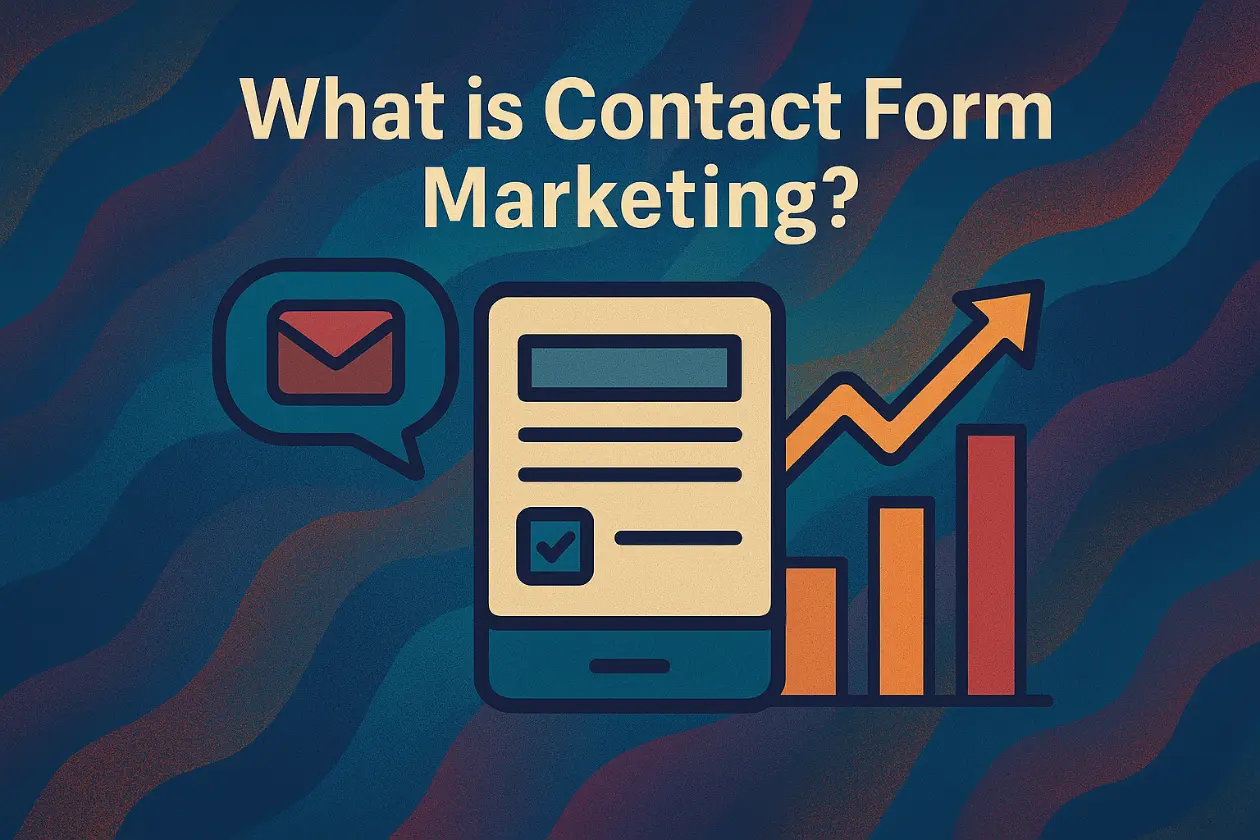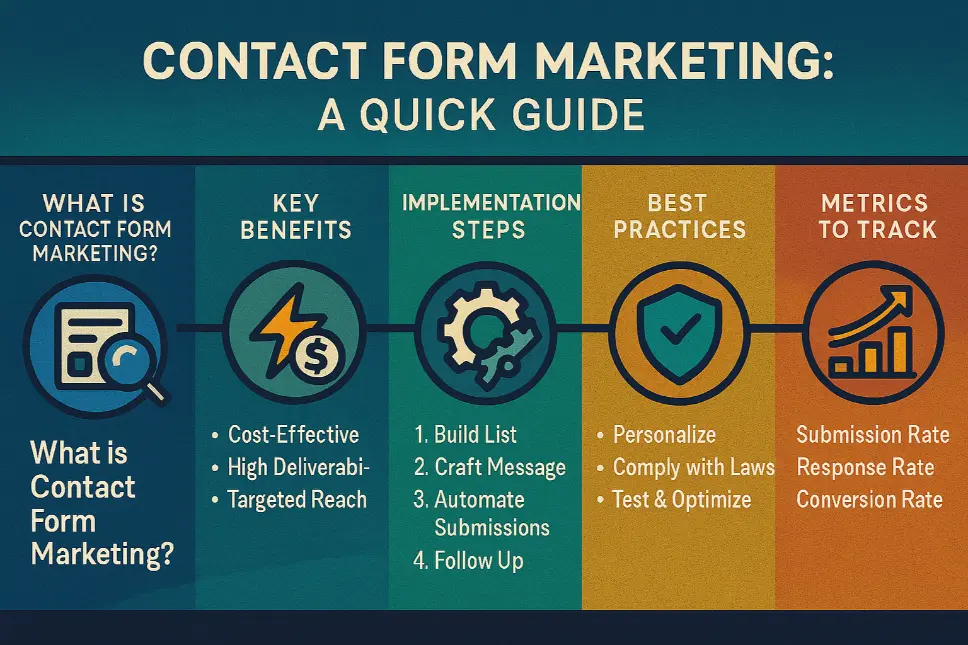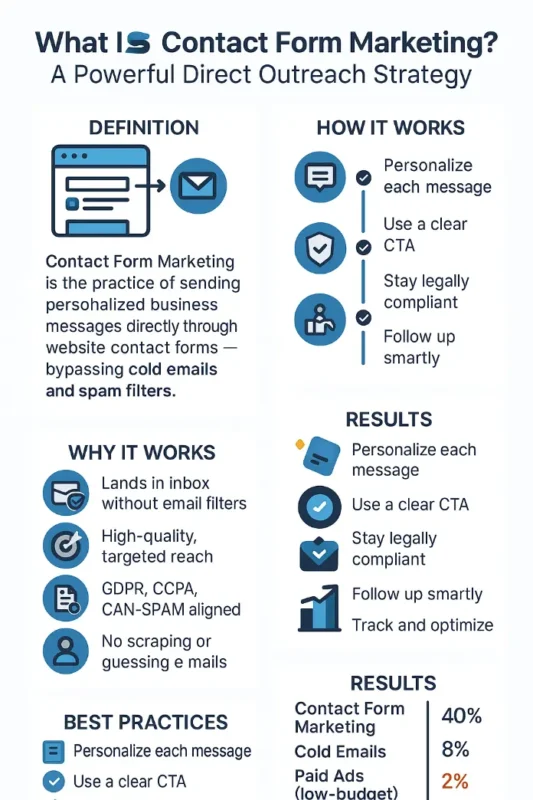What Is Contact Form Marketing? A 5-Minute Primer for Busy Founders

Busy startup founders and marketers are constantly seeking scalable ways to generate leads without tripping spam filters or burning countless hours. Contact form marketing might be the outbound strategy you’ve been overlooking. In this 5-minute primer, we’ll break down what contact form marketing is, how it works step-by-step, its benefits and use cases, real-world success examples, and key considerations to keep your outreach effective and compliant.
What is Contact Form Marketing?
Contact form marketing (also known as contact form outreach or bulk contact form submissions) is a lead generation strategy where you send messages to potential customers via the contact forms on their websites, rather than emailing them directly. In essence, it’s like knocking on the digital front door of a business by using their “Contact Us” form to introduce your product or service. This method allows you to reach prospects at scale while not affected by many of the challenges of cold email outreach (spam filters, finding addresses, send limits, etc.).
Key features of contact form marketing include:
- Using website forms for outreach: You fill out companies’ existing Contact Us or Get in Touch forms with a tailored message, instead of sending an email to their inbox.
- Scalable, targeted messaging: With the right tools, you can submit personalized messages to hundreds or thousands of websites that match your target customer profile (large-list targeting for outbound lead generation).
- Inbox-safe delivery: Messages sent via contact forms are delivered internally (often to an email or CRM monitored by the business) without the typical email deliverability hurdles – meaning your outreach is virtually immune to spam filters.
Businesses put contact forms on their sites because they want to be contacted. Each submission goes directly to a team or inbox dedicated to handling inquiries, so your message lands where it’s expected, rather than getting buried in someone’s personal spam folder. In short, contact form marketing is a professional, highly targeted outreach technique that can open conversations with prospects in a way that’s both efficient and “inbox-safe.”

How Contact Form Marketing Works (Step by Step)
Contact form outreach can be done manually, but it’s often powered by automation tools for efficiency. Here’s a simple step-by-step breakdown of how it works:
- Build a List of Target Websites: Identify the businesses or websites you want to reach (e.g. by industry, location, or keywords). You don’t need individual emails – just the site URLs will do. Many marketers use scraping tools or services to collect a list of target website URLs that have contact forms.
- Prepare Your Message: Craft a concise, personalized message for the contact form. This should include a clear introduction, the value proposition of your product/service, and a call-to-action (e.g. request a call or demo). Keep it non-spammy in tone – be polite, relevant, and to the point (remember, you’re essentially dropping a note to their general inquiry box).
- Submit the Contact Forms: Using an automation tool or VA, systematically visit each target website’s Contact Us page. Fill in the required fields (usually name, email, subject, message, etc.) and submit your message. Tools can automate this browser-based form filling across many sites, often solving CAPTCHAs or other checks as needed. Each submission goes out individually from the website’s server to the company’s designated contact email/CRM.
- Confirmation and Tracking: After submission, you might receive confirmation emails from the website or see a “Thank you” page. Keep track of which sites you’ve contacted (automation software typically provides a report). Use a valid reply-to email address in the form so that responses from prospects reach you.
- Follow Up on Responses: When interested leads reply (usually via email, since you provided your email in the form), respond promptly. Treat it like any inbound inquiry – answer questions and schedule a call or demo. If a prospect doesn’t respond immediately, a gentle follow-up email after a week can help, since some may miss the first message.
Best Practice: Customize your message for different target segments. A little personalization (like mentioning the company name or a relevant detail) can go a long way in showing your outreach isn’t just automated spam. Also, be sure to comply with any guidelines the contact form specifies (some might ask you not to solicit; use judgment).
Contact Form Marketing Overview: The infographic above shows how the process works, from identifying target websites to receiving replies. It also highlights key benefits such as inbox-safe delivery (no spam filter issues) and higher response rates achieved through contact form outreach. For busy founders, this visual encapsulates why this method can be a game-changer for scalable lead generation.
Benefits of Contact Form Outreach
Why bother with contact forms instead of traditional cold emails? It turns out this approach offers several distinct advantages for outbound marketing:
- Nearly 100% Deliverability: Unlike cold emails that can bounce or get caught in spam, contact form messages are delivered through the website’s own system directly to the business. This means no SMTP hurdles or spam filter blocks – one service provider even touts contact form marketing as “100% safe” because it’s virtually unaffected by spam filters. Your message reliably reaches the intended recipient (usually ending up in their inbox as a submission from their website).
- Higher Visibility & Response Potential: Companies actively monitor their contact form submissions – often, those messages go to a dedicated support or sales team. As the founders of one Y Combinator startup noted, businesses with contact forms expect to receive inquiries, and those submissions are handled by staff ready to help. In other words, you’re knocking on a door that’s open, rather than barging into an unwelcome inbox. This can translate to better open and reply rates. (For example, one outreach campaign reported a 26% reply rate using contact form sends – dramatically higher than the ~5% average response rate for cold emails.)
- No Need for Emails or List Building: You don’t have to hunt for individual email addresses or buy lead lists. As long as a company has a contact form, you have a communication channel. This makes prospecting easier, especially in industries where direct emails are hard to find. It’s a form of lead generation that leverages publicly available channels every business provides.
- Scalable Outreach (Without Email Limits): Traditional email outreach requires domain warm-up, sending limits (to avoid getting flagged as spam), and careful scheduling. In contrast, with contact forms you can send as many messages as you want, as fast as you want – there are no daily caps because each message is sent individually on each website. This massively scalable approach lets you target a large volume of prospects in a short time. (Of course, quality still matters; blasting thousands of generic messages will yield poor results. Aim for targeted, high-quality submissions at scale.)
- Compliance-Friendly and Opt-out Control: Since you’re using the business’s provided contact channel, you’re less likely to violate anti-spam laws (more on legal considerations below). Additionally, you won’t create an “unsubscribe” list headache – if someone isn’t interested, they can simply ignore or delete the inquiry, or you can note them as a no-response. You won’t be repeatedly emailing the same person unless they engage.
In short, contact form marketing allows large-scale, targeted outreach with the deliverability of an inbound inquiry. Your message arrives through a trusted channel (the company’s own website) rather than looking like an unsolicited email from a stranger. When done professionally, this method can yield significantly more eyeballs on your pitch and more replies, ultimately filling your sales pipeline faster.

Use Cases and Real-World Examples
Contact form outreach is especially popular among B2B companies, agencies, and service providers. Here are a few common use cases and success stories:
- B2B Lead Generation for Agencies: Suppose you run a marketing agency (SEO, web design, etc.) targeting small businesses. You could compile a list of 1,000 local business websites and send each a helpful pitch via their contact form (“Hi, I noticed your website could use X… we specialize in that.”). Many agencies have quietly used this tactic to land clients. For example, a social media marketing freelancer automated contact form submissions to reach thousands of businesses – he signed up around 50 new clients in a few months. This far outperformed his earlier cold emailing efforts. The key was a personalized approach that didn’t come off as spammy, offering genuine value to each business owner.
- SaaS Product Outreach: Early-stage SaaS startups often lack extensive email lists. With contact form marketing, a SaaS founder can target websites of potential clients by vertical. For instance, a SaaS offering cybersecurity solutions might submit messages to 500 tech company websites, introducing their tool and offering a free security audit. Because the outreach comes through contact forms, these messages reach IT managers or owners more reliably. One startup combined direct emails with contact form outreach to book 19 product demos in a single campaign, achieving a 26% overall reply rate – far above typical cold email results – which led to multiple paid conversions.
- Partnership and B2B Collaboration Outreach: Looking for business development opportunities or partnerships? Contact forms can help there too. Let’s say you want to partner with e-commerce sites to bundle your service. You can propose the idea via their contact form. Because partnership inquiries are less common than customer leads, your message may stand out positively. Many companies have specific staff (or even the founder) reading partnership inquiries, meaning a well-crafted proposal can get a quick response. This is a smarter play than a cold LinkedIn message that might never be seen.
- Hard-to-Reach Niches: In some industries, decision makers don’t list emails publicly and are insulated behind generic contact forms. Rather than hitting a dead end, use that form! For example, government or education sector websites often only have a contact form. Vendors have successfully used contact form marketing to reach school administrators or government procurement officers by sending tailored messages through official site forms, opening doors that cold emails couldn’t.
Each of these examples underscores a point: contact form marketing works best when your message is relevant and professional. It’s not about spamming every website you can find; it’s about reaching the right prospects through a channel they’ve provided, with a message that speaks to their needs. When executed with care, the results can be impressive – from dramatically higher response rates to substantial new business won.
Best Practices for Effective Contact Form Marketing
To ensure your contact form outreach is well-received and effective, keep these best practices in mind:
- Keep It Personal and Relevant: Avoid looking like a bot. Use merge fields or manual personalization for at least the company name or industry in your message. Reference something specific (e.g., “I noticed on your site that…”) if possible. A personalized message is far more likely to get a response than a generic template blast. Focused, relevant outreach is key to not annoying the recipient.
- Mind Your Tone – Be Professional, Not Spammy: Since many businesses get some spam via their forms, you want to differentiate yourself with a clear, honest tone. Don’t use all caps, clickbait, or overly salesy language about “guaranteed results” etc. Instead, briefly introduce yourself, explain the value or solution you offer, and suggest a simple next step (like a call). Keep it under a few short paragraphs. Polite, concise, and value-oriented messaging will come across as legitimate rather than spam.
- Include Contact Info and Respect Their Time: Always provide a real reply email (and phone number, if appropriate) in the form so they can easily contact you back. This builds trust – it shows there’s a human on your side. Also, get to the point quickly in your message. Busy founders and executives appreciate brevity. A good rule of thumb is 3–5 sentences for the main message body. If they’re interested, they’ll read more on your site or in a brochure you can send later.
- Use Automation Wisely: Tools like Paigham Bot, ScrapeBox, or newer AI-based form submitters can automate the heavy lifting of finding forms and submitting messages at scale. But you should configure them carefully: target specific industries or keywords (so your list is relevant), throttle the speed if needed (to avoid any IP blocking by websites), and always test on a small batch first. Ensure the form fields are being filled correctly. Automation is powerful, but it should never be “spray and pray.” It’s better to contact 500 well-targeted websites with a great message than 5,000 random sites.
- Track Responses and Follow Up: Treat contact form outreach like a campaign – track which sites you contacted and monitor replies. If someone responds showing interest, move them into your normal sales funnel and follow up like you would any inbound lead. For those that don’t respond, you might send one polite follow-up email (since you have their email from their reply-to) referencing that you reached out via their contact form earlier. Don’t overdo it – if there’s no reply after one follow-up, move on. Because contact form outreach doesn’t give you explicit “open” tracking, your best gauge of success is the reply rate and the quality of replies. Use those metrics to refine your targeting and messaging over time.
By following these practices, you’ll maximize the chances that your contact form marketing comes across as a thoughtful business proposal landing in the right hands, rather than a junk solicitation. The goal is to initiate a conversation, so make it as easy as possible for the reader to say “Yes, I’m interested – let’s talk” and not give them any reason to hit delete.
Legal and Deliverability Considerations
One of the appealing aspects of contact form marketing is that it sidesteps many traditional email marketing headaches. Still, you should be aware of a few legal and technical considerations:
- Anti-Spam Laws: When you send a message via a website form, you are not emailing the person directly – you’re using a communication method they provided. This generally keeps you in the clear with laws like CAN-SPAM, since you’re not bulk emailing or using purchased email lists. In fact, contact form outreach is often considered perfectly legal and a legitimate way to contact businesses. That said, your message should still respect general anti-spam principles: don’t use false claims, offer something relevant, and honor any requests not to be contacted again. (If a company’s form or site explicitly says “not for solicitations,” it’s best to skip it to avoid any potential complaints.)
- GDPR and Data Privacy: If you’re reaching out to companies in regions with strict data laws (like the EU’s GDPR), remember that any personal data you collect/use (even just the contact person’s name or the fact that you contacted them) could fall under regulation. The good news is, when a user submits a contact form, they are willingly providing their information – so when you use a contact form to reach out, you’re interacting with the business’s system, not scraping personal emails from somewhere else. Still, be transparent and honest in your message about who you are and why you’re contacting them. As long as you use contact forms ethically and respect any personal data, this method can be GDPR-compliant. If a company replies and asks to remove their info, simply don’t contact them again (similar to honoring an unsubscribe).
- Deliverability and Technical Setup: With contact forms, you don’t need to worry about setting up email servers, authentication (SPF/DKIM), or your sender reputation. The deliverability is handled by the website itself. Your focus should be on not triggering the website’s own spam defenses. Many forms have CAPTCHA checks or simple question filters – you can use tools that can solve or bypass these but this is not recommended as a captcha user uses captcha to block bot submissions. Also, extremely short or spammy messages might get flagged by some form plugins’ spam detectors. To be safe, avoid using known spam trigger words and consider breaking up large campaigns over multiple days if you’re hitting many forms (to avoid any IP rate-limiting). The bottom line is that contact form submissions are virtually immune to traditional email spam filters, which is a huge advantage, but you should still send quality content that won’t be mistaken for bot spam by the websites themselves.
- Company Policies: In rare cases, a company’s website terms might say that unsolicited business proposals via the contact form are not allowed. While enforcement is uncommon, it’s wise to quickly scan for any “no unsolicited offers” notes on the contact page. In practice, most businesses don’t post such notices and many welcome inquiries that could be mutually beneficial. Using a respectful tone and relevant offer will further ensure your outreach is seen as a genuine opportunity, not a nuisance.
In summary, contact form marketing is a legitimate, legal outreach method when done correctly. Thousands of B2B marketers use it to reach prospects without running afoul of spam laws or deliverability issues. Just apply common sense: target businesses likely to benefit from your message, be honest about who you are, and respect any negative responses. This way, you can confidently scale up your outreach knowing you’re staying on the right side of both the law and professional courtesy.

